Disclosure: Meeple Mountain received a free copy of this product in exchange for an honest, unbiased review. This review is not intended to be an endorsement.
Overview
Renegade takes place in a dystopian future. The players represent hackers who are taking on the Super-Massive Computer (SMC) called ‘Mother’ in an effort to shut it down and restore humanity to the mindless masses. During the game, the players will jack into the network and, utilizing the cards in their hands, work together to infect the system with various contaminants to overcome Mother’s various countermeasures and defenses to bring her down. The game uses elements of deckbuilding, pick up and deliver, and hand and resource management to achieve these ends. If the players can survive everything that Mother throws at them, they will win the game. But if they fail, Mother wins, and the last beacon of hope for humankind will be snuffed out.
Contents
The game of Renegade comes inside of a sleeved box which contains a bevy of cards and tokens along with several character sheets, five server tiles which combine to form the playing area, several dice, 4 avatar standees, and a rule book. The tokens are divided into two main types – contaminants and countermeasures. The cards are divided into several types – Basic Command cards in 4 different colors, 36 Advanced Command cards, 5 SMC cards, and 24 countermeasure cards – which I will discuss in more detail later.
There are four different types of dice – a Server die, a Partition die, and 2 Infection dice (one black and one red). The components that came in our review copy are of decent quality although I had to perform some magic to make the standees stay upright as it looks like the slits that were cut into their bottoms to hold the stands in place may have gotten cut a little too wide. These things are to be expected from a prototype, though, so I am not complaining. If this is the prototype, I look forward to seeing the final product because, as far as prototypes go, this is a pretty good one.
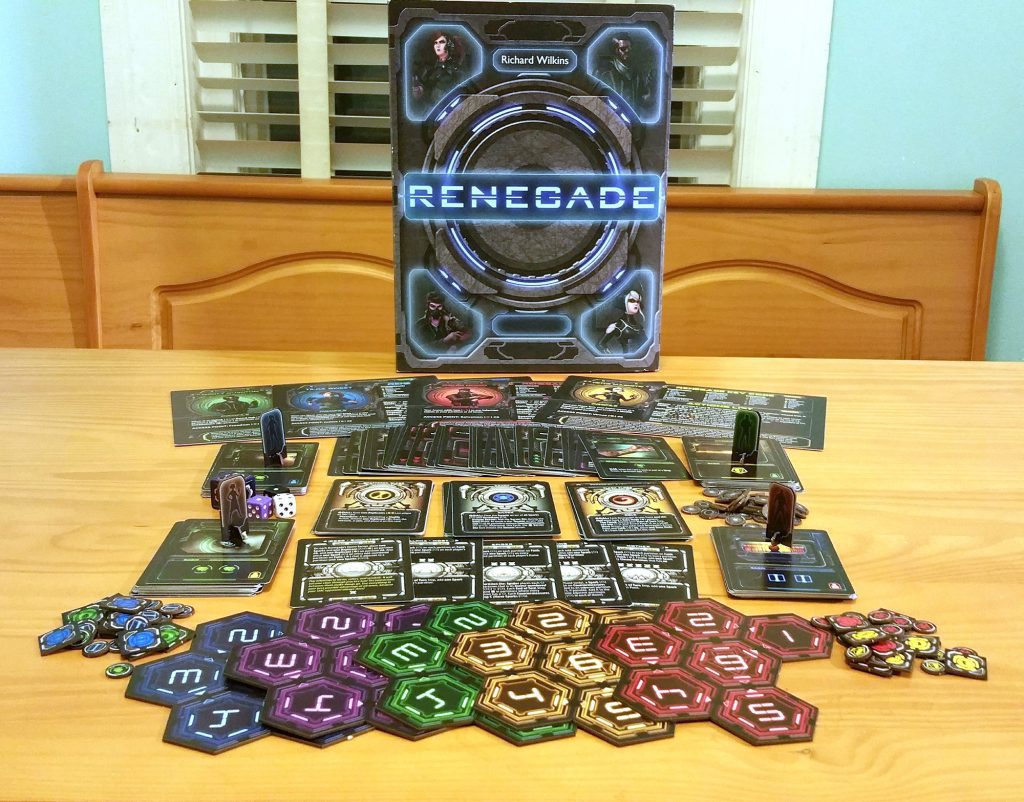
The artwork in this game is pretty good and definitely oozes with cyberpunk flair. The artist, Clark Miller, has done an excellent job here and is to be commended. And, while I am handing out commendations, whoever wrote and laid out this rule book should be commended as well. The rule book for Renegade is one of the most thorough and best laid out rule books I have ever seen in a game. It’s loaded with content – rules, examples, and even a full playthrough of several sample rounds that the player can follow along with in order to better learn the game. Not only is the rule book well put together, it’s very eye appealing as well. It is obvious that a great deal of time has been spent getting it right and I definitely appreciate the effort as a reviewer. Too often with Kickstarter games, not enough attention is paid to the rules and I’m glad that isn’t the case here.
Now, if you’re bored by game play details, feel free to skip ahead to the Thoughts section.
Go ahead. I’ll understand.
Otherwise…
Setup
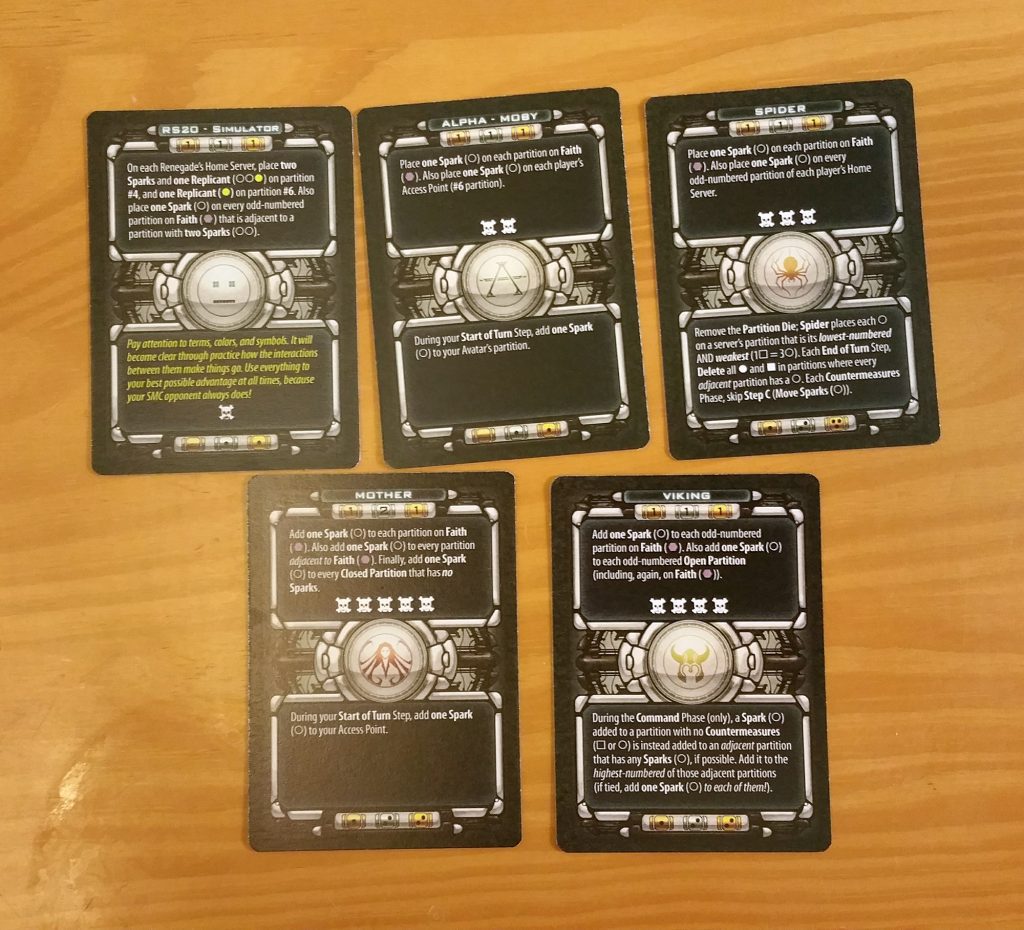
The setup for the game is fairly simple. First, one of the SMC cards is chosen. Increasing in difficulty, these cards define the starting conditions of the server as well as the number and type of countermeasures that the players will be up against during the course of the game. Once the SMC card has been selected, the three countermeasure decks are shuffled into separate piles and the appropriate number of cards from each (defined by the chosen SMC) are drawn and placed into a deck. The unselected countermeasure cards are returned to the box. Next, the server is assembled.
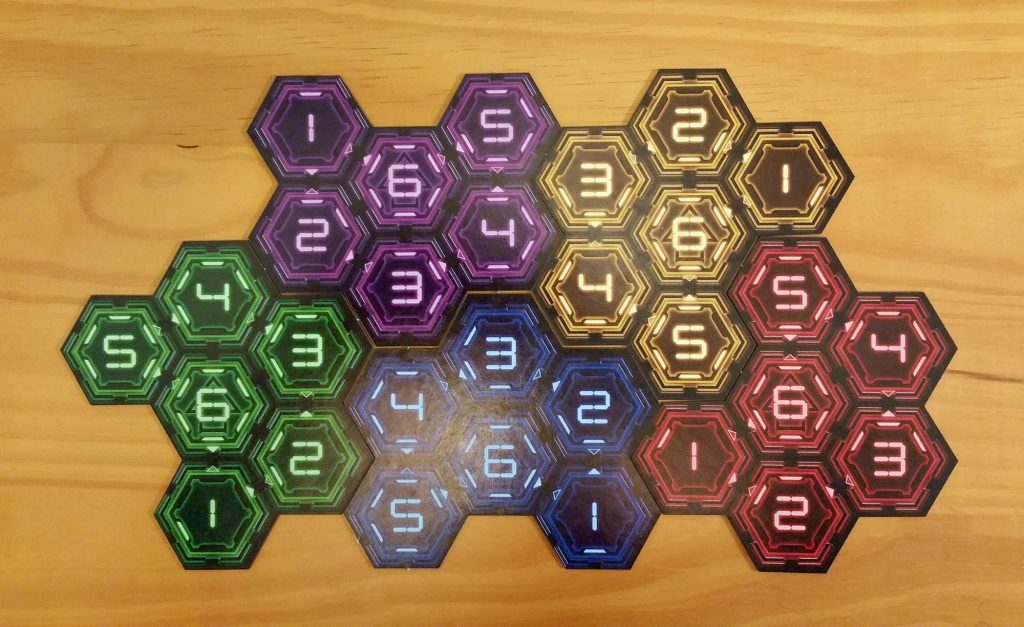
There are five different server tiles, each a separate color, that are divided into 6 numbered “partitions”. Starting with whomever the group agrees should be the starting player, the players will take turns drawing and placing the server tiles into the game area such that every tile after the first has at least two partitions touching two other partitions. Any partitions that are along the outer borders are considered to be ‘open’ and the others are ‘closed’.
Once the server has been created, the players choose their avatars, take the Basic Command cards of the chosen color, and place the standees into their starting positions along with contaminant tokens of their avatar’s color. Then some countermeasures will be added to the server according to the setup instructions on the SMC. After all of this has been done, the Advanced Command Cards are shuffled into a deck and four are placed face up to form a store – the Hack Shack in game terminology. Then each player shuffles their deck of command cards and draws five to begin the game. Now you’re ready to go.
Your starting setup might look something like the image below, but due to the modular nature of the server tiles, it may look different:

Anatomy of a Round
A round of Renegade (called a Cycle in game terms) is broken down into several distinct parts:
- Intel Phase – in which the players determine their objectives for the round (defined by the Countermeasure card)
- Command Phase – in which the players play cards from their hands to move around the server adding contaminants and defeating the server’s defenses all while trying to achieve the round’s objectives
- Countermeasures Phase – in which the SMC takes its actions and bad things happen and the success or failure conditions for the round are applied
- Refresh Phase – in which unpurchased cards are discarded from the Hack Shack and replaced with new ones and players reshuffle their decks and draw new hands in preparation for the next round provided an end condition has not been met
There are two game ending conditions. The game ends after the last countermeasure card has been assessed OR when the players are forced to place a countermeasure token onto the board and there are no more of the appropriate type to place. In the first case, you win. In the latter, you lose instantly.
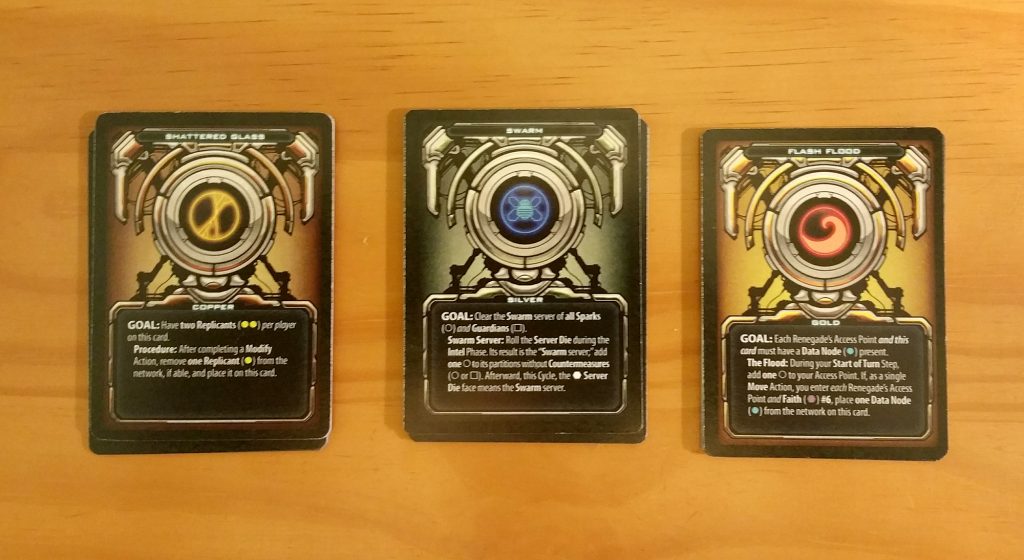
Contaminants, Installations, and Countermeasures
Now, this is just a high level overview of how these things work. I don’t want to go into too much detail about them. If you’d like to know the nitty gritty details, then I implore you to go check out the Kickstarter page for the game or the game page over on Boardgamegeek.
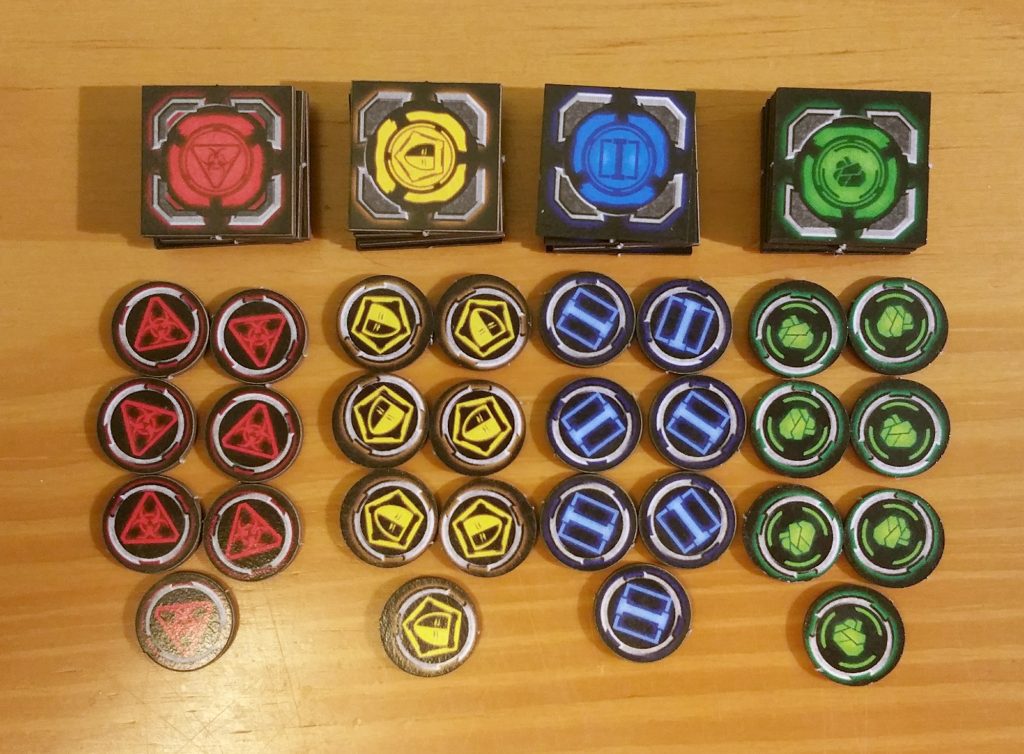
In the game of Renegade, you’re going to have two primary goals: introduce contaminants into the system and defeat the system’s countermeasures. Contaminants are tokens that do things and each one provides the players with a unique power. For instance, there are contaminants that allow players to move more freely from partition to partition, to destroy countermeasures, or to convert them into other useful contaminants. However, putting these into play isn’t free. In order to put them into play, you’ve got to use the right cards to do so.
Placing a contaminant token into play of any color requires three symbols of the appropriate color. If you’ve already got three contaminant tokens of the same type there, then you can upgrade them into an installation of the same color. Installations are beefier versions of their respective contaminants and offer upgraded abilities (i.e. the ability to teleport from one installation to another, for instance) that make it easier for the players to achieve their goals.
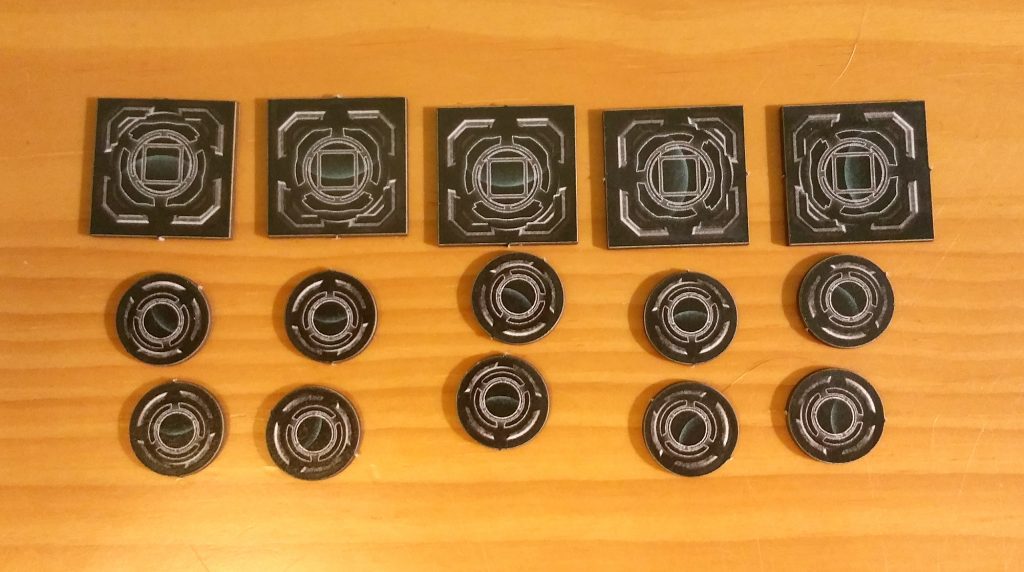
Standing in your way are the system’s defenses (its countermeasures) which come in two main types – sparks and guardians. Sparks are relatively harmless in and of themselves and are relatively easy to defeat. Their main function is to prevent the players from uploading contaminants into partitions in which the sparks reside. During the Countermeasures phase, they will also delete any contaminants that have been left on the partition with them. Left unchecked, they can multiply and combine to form into guardians.
Guardians also prevent the upload of contaminants, are much tougher to remove than sparks, and can delete installations during the countermeasure phase. In addition, in the right circumstances, guardians can produce a cascading chain of more sparks and more guardians. Since running out of sparks or guardians is a game ending condition, this could be a very, very bad thing indeed.
The Commands and the Hack Shack
A hacker is only as good as his tricks and a hacker’s tricks are determined by the cards that he holds in his hand. There are five different colored symbols that will show up on the various cards and four of these colors are associated with a specific command while one is a wildcard that can be used as any color. The colors and their associated commands are:
- Movement: this is how the players will move around the server.
- Shift: this allows players to push around contaminants tokens and sparks.
- Virus: this is how players can fight sparks and guardians straight up
- Replicant: this is how players can turn sparks into useful contaminants
- Wild
In addition to using the symbols on the cards to power the different contaminant abilities, these symbols also function as the money used to purchase cards from the Hack Shack. Each of these Advanced Command cards has an associated cost. To pay the cost, the player discards the number and type of symbols that are shown in the cost. The purchased card is added to the player’s hand where it is available for immediate use and then the player must remove one of the cards used to purchase the new card from the game. In this way, each player’s deck will always be comprised of exactly 15 cards.
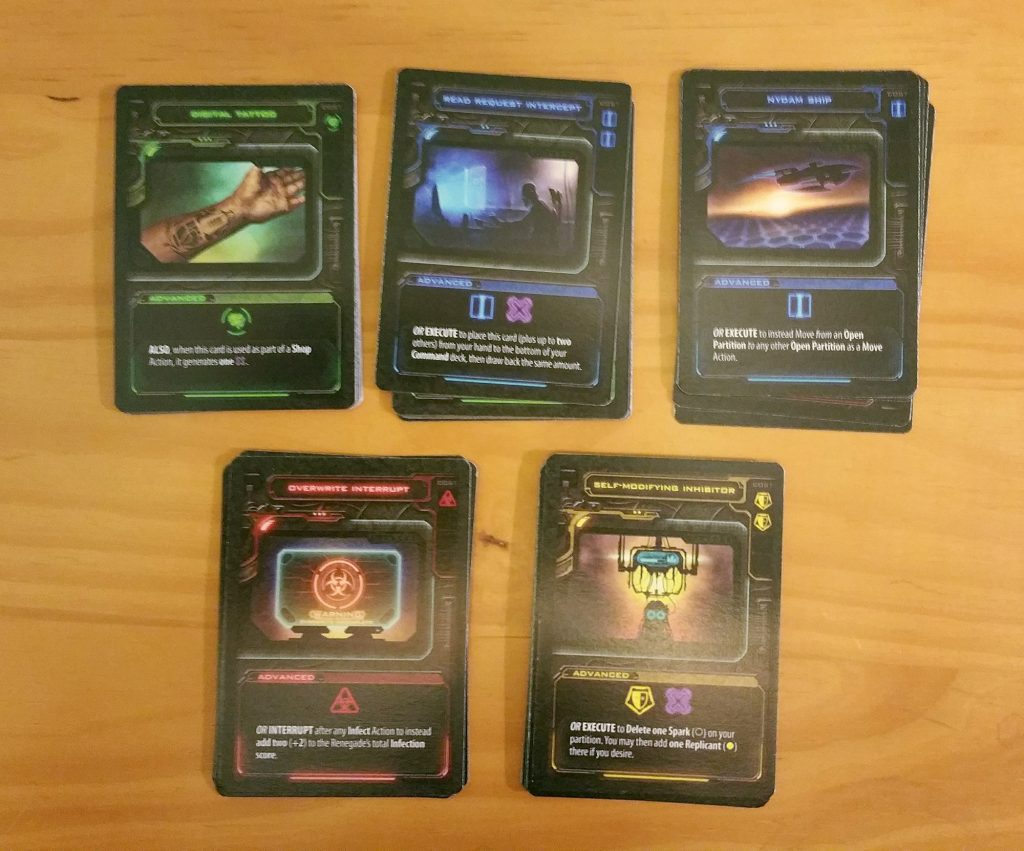
Thoughts
It’s been said that there are no new ideas left in boardgaming, but merely remixed ones. That is certainly true for Renegade. Anyone that’s ever played Pandemic before (apologies if you haven’t) will instantly recognize the similarities between viral outbreaks and spark explosions. Anybody that’s ever played a deck building game before will recognize the benefits of thinning your deck of the basic beginner cards and replacing them with better things. Anyone that’s ever played a game where you’re tasked with completing a certain objective within a given timeframe will instantly recognize that mechanic as well. When designing a new game, it can be a real challenge to take what’s already been done, remix it, and come up with something that, while familiar, also feels like something exciting and brand new. Richard Wilkins has managed this feat with Renegade.
At first glance, I wasn’t impressed. Reading through the rule book, I kept thinking to myself “This is just cyberpunk Pandemic” and it wasn’t until I actually played the game that I realized just how wrong I was. While it’s true that things can get out of control fairly quickly if they’re not kept under control, it’s the method that the players use to maintain this control that sets Renegade apart and makes it its own. It isn’t enough to just be in a spot in order to affect the game. You’ve also got to have certain conditions in place to make things happen and whether or not you can get these conditions into place to begin with is dictated by a host of other factors – the cards in your hand, the state of the game board, the obstacles in your way, etc.
I really like that the game puts the players into the position of having to decide whether to focus on the round’s objectives or to just let them go in favor of keeping the bad things under control. I especially like the fact that, as a player, your deck thinning efforts reap immediate rewards whereas in most other deckbuilders you’ve got to wait several turns for the newly purchased cards to cycle back into your hand.
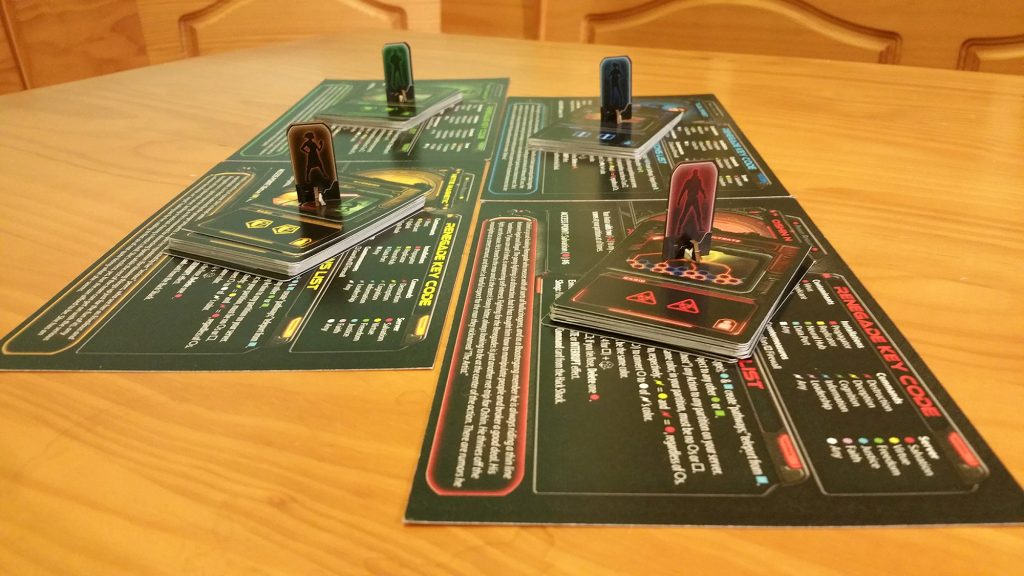
I like that the randomized server layouts and different decks of countermeasure cards present new and unique challenges each and every game. Sometimes the cards seem to have a synchronicity while other times they’ll send you scurrying in a hundred different directions. In one solo game that I played, the first countermeasure required me to have one contaminant of each type present in the same partition by the end of that game cycle. I managed to succeed at that challenge easily. A later countermeasure forced me to remove contaminants in a very specific order in order to succeed. Luckily, I hadn’t actually moved any of the contaminants off of that previous partition and, since there was a green token present and I was standing on a partition with another green token, I was able to use a very effective shift action to knock out the countermeasure’s requirement in one single, almost effortless turn. In another game, though, none of the objectives seemed to have any kind of synchronicity at all and, as a result, that game turned into a miserable failure as we were soundly defeated by the SMC.
And this brings me to my only negative point about this game. Due to the presence of dice and card drawing, there is a large degree of randomness in this game and that might be an instant turnoff for some. Typically, it would be a turnoff for me as well. I value having a lot of choices and options and I like the feeling that I have either thrived or failed based solely on the decisions that I have made and the skill that I exercised in making those decisions. Fortunately, Renegade never leaves me feeling like I just lost due to sheer dumb luck. I always feel like there was something that I could have done better or that there was a better choice that I could have made. It puts me into a position where, when I’m not actively playing the game, I am thinking about the game and looking forward to the next time that I get to play it. If that’s not a hallmark of a good game, then what is?
I was a skeptic at first, but Renegade has made a believer out of me. This is one cooperative game that’s worth taking a look at.
What do you think about Renegade? Give us your opinions about what you like and/or dislike about the game in the comments below!










